COVID Update: Navigating the Consequences of Airborne Ignorance in the Age of JN.1. A New Coronavirus with 100% Mortality. COVID is Messing With Our Minds
Nearly Half of U.S. States Show Increasing Positivity Rates
U.S. COVID wastewater prevalence is declining from the peak of the second biggest surge of the pandemic however the overall trajectory is headed in the wrong direction.
While there's an overall decrease in wastewater prevalence, concerning signals indicate that this decline is gradually decelerating and even reversing in numerous regions. Data from Walgreens reveals that in nearly half of the states, positivity rates are on the rise.
The overall trend in the positivity rate indicates an escalating baseline, prompting questions about our level of control. Does this look like a pandemic that is over? We find ourselves in the midst of a global health crisis. Massive surges of new variants, overcoming previous immunity, are swiftly spreading worldwide, leading to extensive repercussions such as increased hospitalization, death, and long-term disability.
Prevalence is poised to remain persistently high as the JN.1 sub-variants, constituting over 90% of cases, dominate the current landscape. The global prominence of the JN.1 variant, lacked sufficient prior warning from public health agencies at every level of government. TACT’s November 5th update highlighted the JN.1 sub-variants potential for global dominance. “Cumulative data suggests that the JN.1 sub-variant of BA.2.86 has the potential to become a global dominant variant.”
The World Health Organization (WHO) labeled it a "variant of interest" on November 10, 2023, a designation that elicits minimal concern these days. TACTs November 5th update stressed the imperative to address the variant's impact on children's developing brains, advocating for immediate measures to reduce airborne transmission in schools and to protect healthcare settings. “Given our limited understanding of this variant's impact on children's developing brains, taking immediate steps to reduce the transmission of airborne viruses in schools and safeguarding healthcare settings is of critical importance.” Now we have a new study, which we will review, that utilizes MRI technology to demonstrate how even mild COVID infections may induce brain damage. This study is one more to add to the many studies before it showing COVID-19 can have long term impacts on cognitive function.
The endless waves of new variants are slowly wearing down our society. The persistent evolution of these variants, marked by increasing immune evasion and suppression with each wave of infections is wearing down people's immune systems, allowing for more persistent infections, which lead to Long COVID. With rising infections of other viruses and bacteria, millions experience a declining quality of life and, ultimately, shortened lives. The latest variants continue to evolve in a dangerous direction., with a growing number of individuals hosting more than one variant which another new study digs into and we will review. As more people are infected with more than one variant it is intensifying the virus's adaptive capabilities against our immune system. The high baseline of transmission ensures swift reinfection for millions, contributing to the virus's persistence and its ability to generate more formidable variants within individuals.
This article explores the concerning evolution of COVID and the increasing risk of immune evasion and suppression, persistence and brain damage. We delve into the new study on coinfections with more than one variant and a number of studies on co-infections with COVID, RSV and influenza in children and adults. We look at a newly discovered coronavirus related to SARS-CoV-2 with a 100% mortality rate in humanized mice. Our analysis also explains why prevalence peaked before New Years, and the critical role of airborne transmission in driving exponential growth, emphasizing the urgency for collective action to protect communities from the long-term consequences of repeated infections and to prepare for the evolution that is headed in a dangerous direction.
The research requires extensive time and effort to uncover crucial insights. By becoming a paid subscriber, you're not only gaining access to this exclusive content but also actively supporting the future of this important work. Contribute to our mission by becoming a valued paid subscriber today.
A huge Thank You to all the paid subscribers supporting this work!
Coinfections with More Than One Variant
Due to the weakened immune response and SARS-Cov-2’s rapid evolution, more and more people will have persistent infections and co-infections with multiple variants and other viruses. Earlier research found that co-infections of more than one variant occur frequently, with an estimated rate of ~0.2–0.6% of the observed infections.
In a study, published January 15, 2024, titled “Systematic detection of co-infection and intra-host recombination in more than 2 million global SARS-CoV-2 samples” they found, "co-infection was observed in 0.35% of the investigated cases." That’s about 7,000 new people per day with coinfections when there are over 2 million people a day getting infected. In 30 days, that’s 210,000 people that have had new coinfections with more than one variant in just the U.S. These are rough numbers but consider that the numbers grow exponentially as new variants are continuing to reinfect people all around the world. Each wave of new variants is more immune evasive and suppressive than the one before it, making persistent infections more and more likely.
Coinfections of COVID, Influenza and/or RSV are More Severe
"Prevalence of SARS-CoV-2 and Influenza Coinfection and Clinical Characteristics Among Children and Adolescents Aged 18 Years Who Were Hospitalized or Died with Influenza — United States, 2021–22 Influenza Season": Co-infected children were more likely to require mechanical ventilation (29.4% vs. 13.8%) and had longer hospital stays (median 5 days vs. 3 days) compared to those with influenza alone. https://www.cdc.gov/mmwr/index2023.html
"Viral Coinfection of Children Hospitalized with Severe Acute Respiratory Infections during COVID-19 Pandemic": Children co-infected with hRV, RSV, or bocavirus alongside SARS-CoV-2 had a higher need for oxygen therapy compared to single-virus infections (56.5% vs. 38.5%). The study suggests co-infection might lead to a greater viral load and a more robust inflammatory response, contributing to respiratory distress. https://www.mdpi.com/2227-9032/11/24/3151
"Coinfection with severe acute respiratory syndrome coronavirus 2 (SARS-CoV-2) and influenza virus during the COVID-19 pandemic": Co-infected patients had higher rates of hospitalization (57.1% vs. 38.5%), ICU admission (38.5% vs. 12.9%), and mortality (23.8% vs. 6.5%) compared to single SARS-CoV-2 infection.https://link.springer.com/article/10.1007/s11596-021-2317-2
"COVID-19 bacteremic co-infection is a major risk factor for mortality, ICU admission, and mechanical ventilation": This study found that bacterial co-infections within 48 hours of COVID-19 hospitalization significantly increased the risk of mortality (42.9% vs. 12.9%), ICU admission (64.3% vs. 36.4%), and mechanical ventilation (51.4% vs. 24.3%).https://www.bmj.com/content/368/bmj.m1201
"Severe acute respiratory syndrome coronavirus 2 and respiratory syncytial virus coinfection in children": This retrospective study from the Journal of Medical Virology investigated RSV and SARS-CoV-2 coinfection in children hospitalized with respiratory infections. They found children with coinfection had higher rates of ICU admission, mechanical ventilation, and longer hospital stays compared to those infected with just COVID-19. (Journal of Medical Virology, 2022) https://www.ncbi.nlm.nih.gov/pmc/articles/PMC8561020/
"Impact of respiratory syncytial virus and human metapneumovirus co-infections on clinical outcomes in adult COVID-19 patients": This research published in the Journal of Hospital Infection analyzed data from adult COVID-19 patients in Brazil. They observed that co-infected patients with RSV or human metapneumovirus (hMPV) had a higher risk of requiring mechanical ventilation and ICU admission compared to those with sole COVID-19 infection. (Journal of Hospital Infection, 2023) https://academic.oup.com/cid/article-pdf/74/12/2252/44479687/ciab969.pdf
"Viral co-infections in critically ill COVID-19 patients admitted to the intensive care unit: A retrospective observational study": This study from the European Journal of Clinical Microbiology & Infectious Diseases examined viral co-infections in critically ill COVID-19 patients. They found that RSV coinfection was associated with increased mortality risk compared to those without coinfection. (European Journal of Clinical Microbiology & Infectious Diseases, 2023) https://www.ncbi.nlm.nih.gov/pmc/articles/PMC8289210/
COVID is Messing With Our Minds
COVID is evolving in a dangerous direction. It has the evolutionary advantage. As long as we allow unmitigated transmission in schools and hospitals to continue, we are aiding its evolution. We can live longer, and we are supposedly smarter, but so far, the virus has retained the upper hand. We must get smarter and take control of this unsustainable situation.
The cumulative cost to individuals, families, and all of society is continuing to grow. An example of this is the brain damage accumulating in society. How is this impacting children's developing minds?
A new paper published January 19, 2024 studied 97 people (with an average age of 41 years old who had a mild COVID-19 infection and no history of mental health issues. This was about 79 to 97 days after they were diagnosed. They used interviews, brain scans, and cognitive tests to understand how the virus might affect the brain. They compared them to 77 people who didn't have COVID-19. The brain scans looked at the white matter using diffusion tensor images, and they also studied brain activity while resting. Some patients mentioned problems like memory loss (36%), fatigue (31%), and headaches (29%). The detailed analysis found that many participants had symptoms like fatigue (83%), feeling very sleepy (35%), trouble with certain types of word games (21%), difficulty with verbal memory (16%), and other issues. Will the damage be permanent? If it isn’t permanent, how can people recover if they are reinfected every 6 months to a year? Many people are reinfected much faster than that and with more persistent infections, the cumulative toll is gaining momentum.
We are on an unsustainable path and completely unprepared for a more potent variant, which could materialize in the near future. How do we discern that this is possible? We can see that over time SARS-CoV-2 is becoming better at evading and suppressing the immune system, which makes it more likely to persist throughout the body and the brain. We already have extensive evidence of this occurring but it will likely continue occurring at higher rates in more people. Additionally, consider that SARS-CoV-1 had a mortality rate of approximately 9-10% and MERS (Middle East Respiratory Syndrome) had a mortality rate of around 35%.
A Coronavirus Similar to SARS-CoV-2 Found to Have a 100% Mortality Rate in Humanized Mice
In a preprint published on January 4, 2024, scientists in Beijing, China found a corona virus related to SARS-Cov-2 that can cause a 100% mortality in humanized mice. What are humanized mice? Researchers used mice engineered to express the human ACE2 receptor, creating a model that mimics how the virus interacts with human cells. These mice are often referred to as "hACE2 mice," emphasizing that they carry the human form of the ACE2 receptor. This type of mouse model is frequently employed in COVID-19 research to study the virus's infectivity, pathogenicity, and potential treatments or vaccines.
The researchers tell us in this study that before the COVID-19 outbreak, researchers identified two coronaviruses related to SARS-CoV-2 in pangolins, named GD/2019 and GX/2017. The isolates, pCoV-GD01 and GX_P2V, were obtained from these coronaviruses and studied in 2020 and 2017, respectively. The researchers investigated the infectivity and pathogenicity of these isolates. The pCoV-GD01 isolate, which is more similar to SARS-CoV-2, was found to infect and cause disease in golden hamsters and hACE2 mice. On the other hand, GX_P2V could infect both species but did not seem to cause obvious disease. It was later discovered that the GX_P2V isolate used initially was a mutated form adapted to cell culture, named GX_P2V(short_3UTR), which had a deletion at the 3’-UTR. The researchers cloned this mutant and tested its ability to cause disease in hACE2 mice. They found that the GX_P2V(short_3UTR) clone could infect hACE2 mice, resulting in high viral loads in both lung and brain tissues and leading to 100% mortality. The researchers suggest that the cause of death might be related to late-stage brain infection.
China has a coronavirus with a potential 100% mortality rate while the U.S., Europe, and the rest of the world are completely unprepared. For now, let's assume the virus is safely contained in a highly secure lab vault. Extensive studies over four years have demonstrated how COVID-19 infiltrates and affects the brain. It is crucial that we work together against COVID transmission to prevent the persistent waves and the consistently high baseline of transmission of brain-damaging variants and any future threats on the horizon. Disregarding airborne transmission poses a threat to society, our way of life, and represents a national security concern demanding immediate attention.
U.S. Wastewater Prevalence
We are seriously lacking surveillance data but from what we can see through the wastewater data, prevalence remains very high in most areas.
Understanding Pathogenic Exponential Growth Between Schools and Homes and Its Implications on Why Prevalence Decreases in January
The W.H.O. and the CDC caution individuals to be vigilant during the holidays, citing the potential for a "holidays surge." This is an extremely misleading statement. We can see in the U.S. wastewater prevalence below that the surge has been increasing for months prior to the holidays. The holiday gatherings and travel absolutely act as mass transmission events spreading new variants around the world, and seeding new communities, however the transmission rate does not surpass the exponential growth halted by the winter break. The hiatus between schools and homes is long enough to disrupt the exponential growth, resetting the exponential curve to the community base rate, leading to an overall decline in prevalence among adults even after kids return to school post-holidays. Unfortunately, without mitigation measures in schools, the exponential growth resumes, restarting the curve.
If the holidays were the primary driver of the exponential growth, considering the incubation time before people have symptoms and for viral loads to build up enough to be seen by wastewater testing, we would expect to see the wastewater prevalence and hospitalizations increasing into mid or late January. Hospitalizations are a lagging indicator because of the incubation time and the time it takes for people to become so ill that they go to the hospital. Despite this, hospitalizations were declining by January 1, 2023 in multiple countries (1st pic below) and by January 4th in the U.S. in both 2023 and 2024. The wastewater prevalence peaked by December 30, 2023 (2nd pic below).
After increasing for several months, on December 30, 2023 the wastewater prevalence stopped increasing and started declining.
The W.H.O. and the CDC should transparently acknowledge that the surge has been accumulating for months between schools and homes, dispelling the misconception that it solely arises from holiday activities. A comprehensive understanding of the factors driving and curbing viral surges is crucial for implementing the necessary measures to safeguard children and communities. The persistent failure to address this issue represents a significant lapse in public health at all levels. Politicians and public health officials seem inclined to downplay transmission in schools, neglecting its role in widespread hospitalizations, disability, and death. Despite these challenges, we have the capability to shift the unsustainable trajectory, requiring a concerted effort to enhance public understanding and advocate for political support at local, state, and national levels. Government investment is pivotal for the success of these crucial efforts.
Help support the Clean Air for Kids campaign to contribute to the enhancement of ventilation and air filtration in schools. This initiative not only safeguards children but also protects teachers, parents, grandparents, co-workers of parents, and the entire community. Your assistance can make a meaningful impact on creating healthier learning environments and go a long way to achieving a sustainable path forward.
Stay tuned for our upcoming update where we'll explore the potential impact of emerging variants and discuss the unfolding situation in the coming months. Additionally, we're diving into numerous new studies and insights. Keep an eye out for valuable information in the week ahead.
Please share any questions or insights you may have. Let us know what is occurring around you.



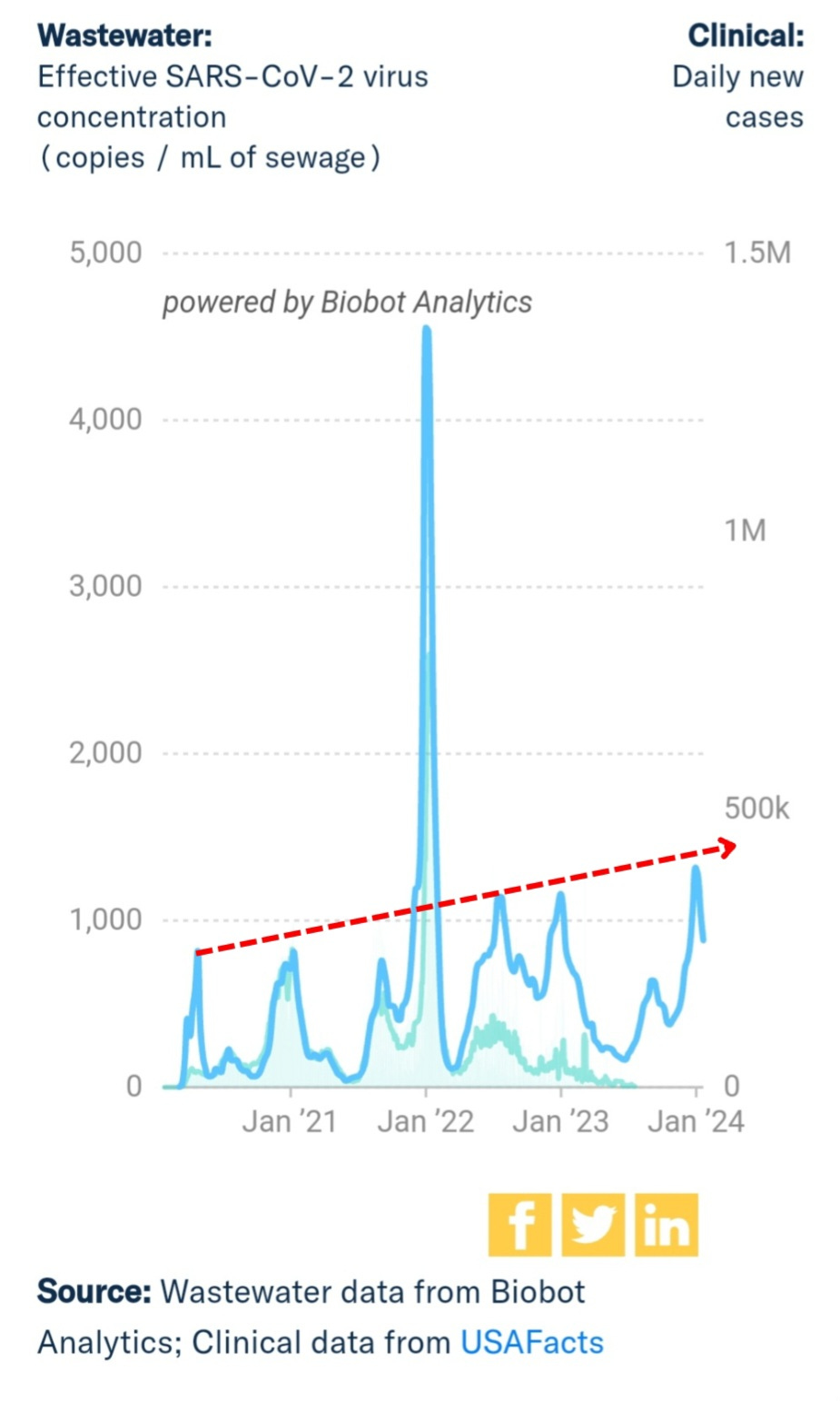
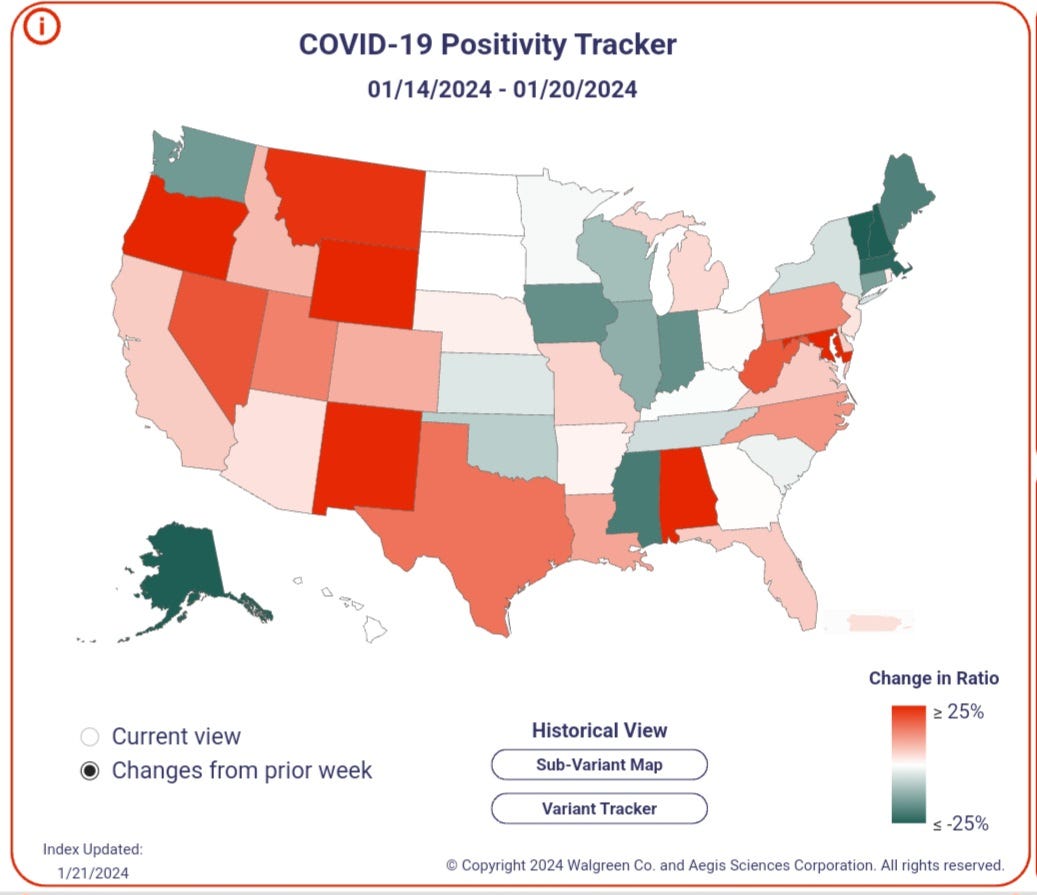
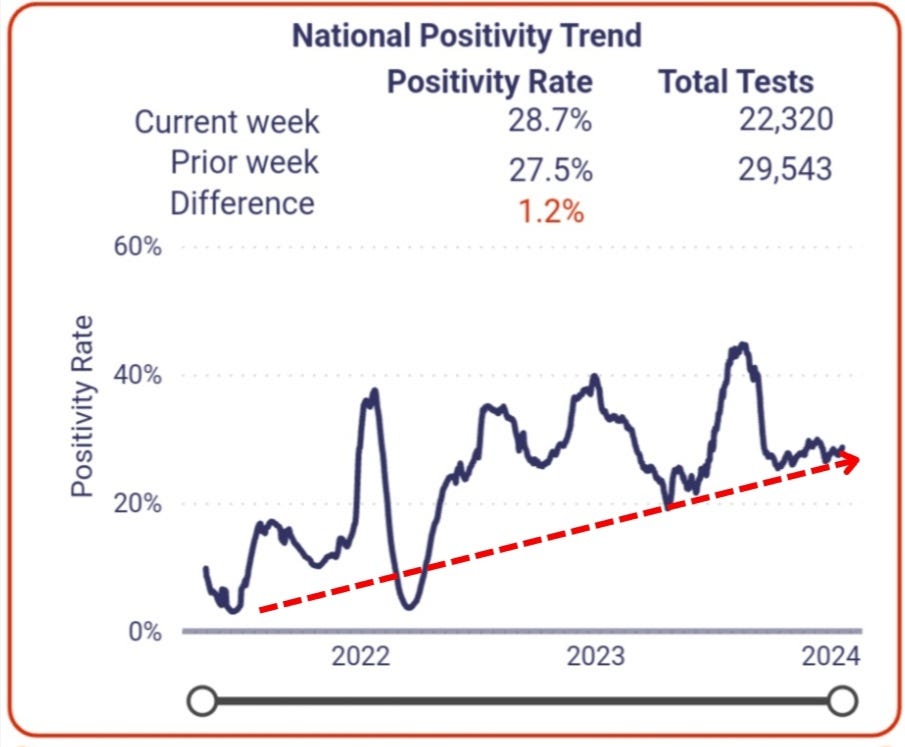
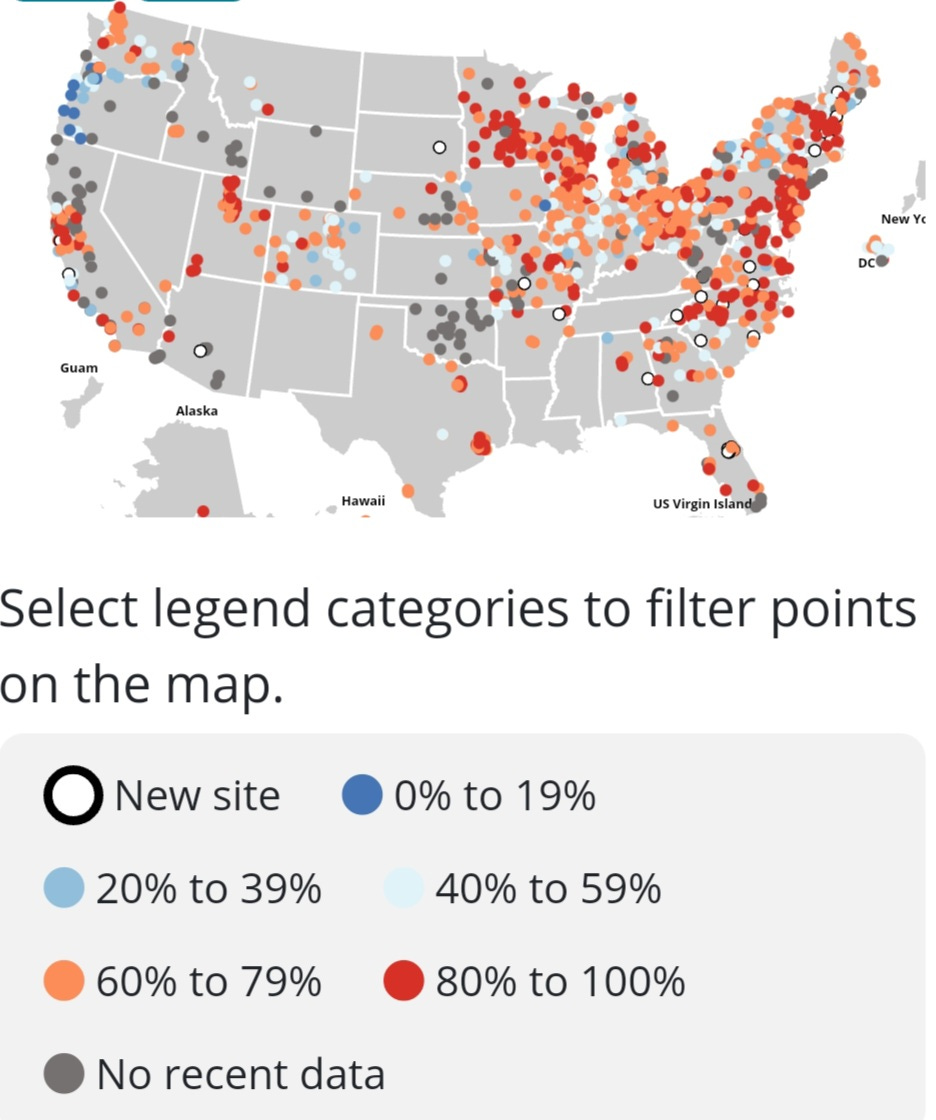
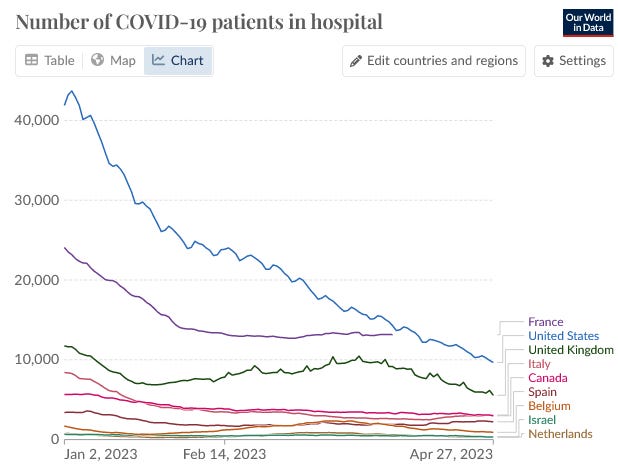
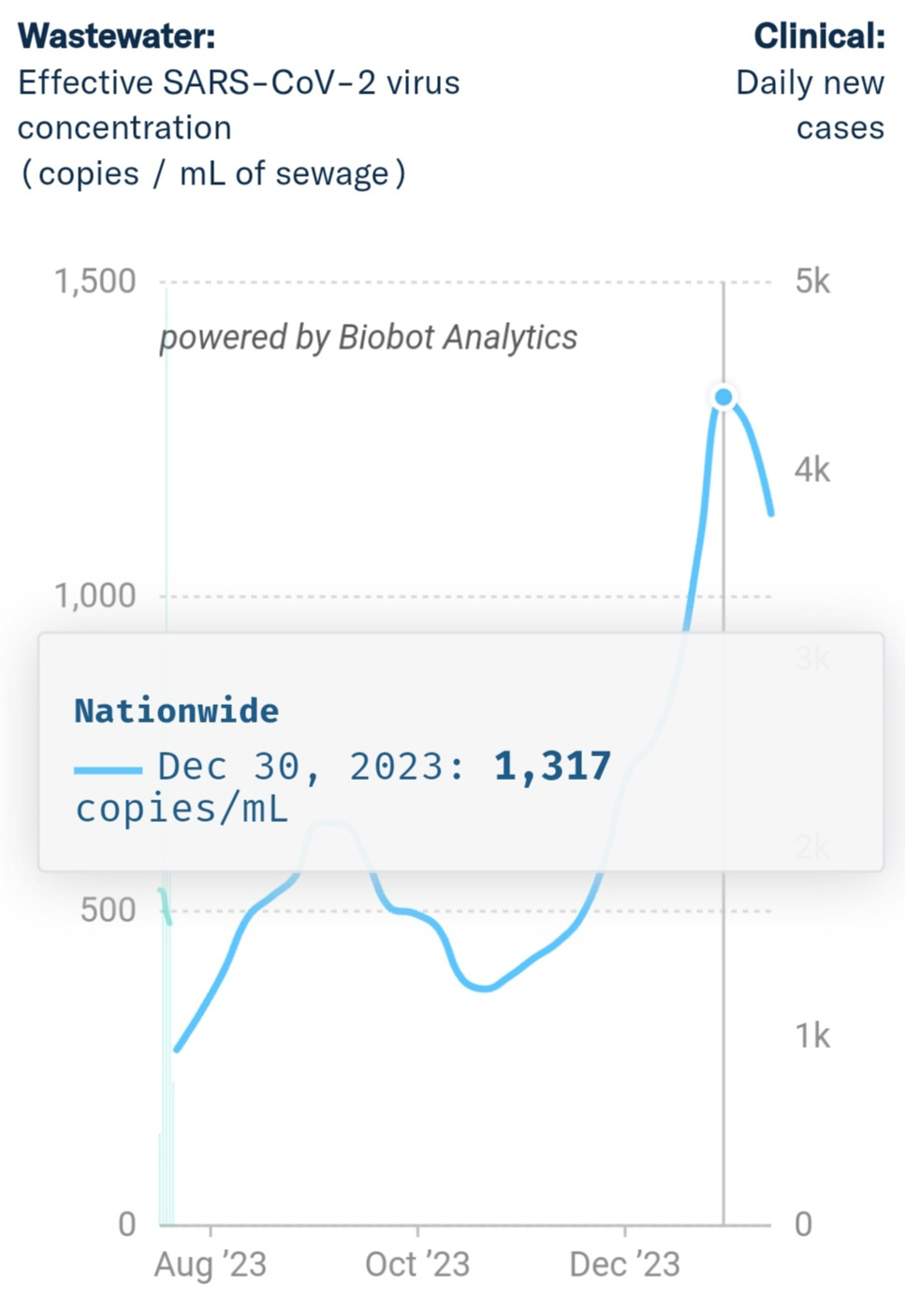

When I switched our small business's filters to MERV13 recently I was told that they aren't good because they harm the air conditioner. I wonder if that is a factor preventing schools from using MERV13?
Hi TACT...Have a look at data.wastewaterscan.org and call up the SARS-CoV-2 data for region 4.
Not much evidence of a wastewater decline here. (However, sometimes the data on this site can be a little squirrely)